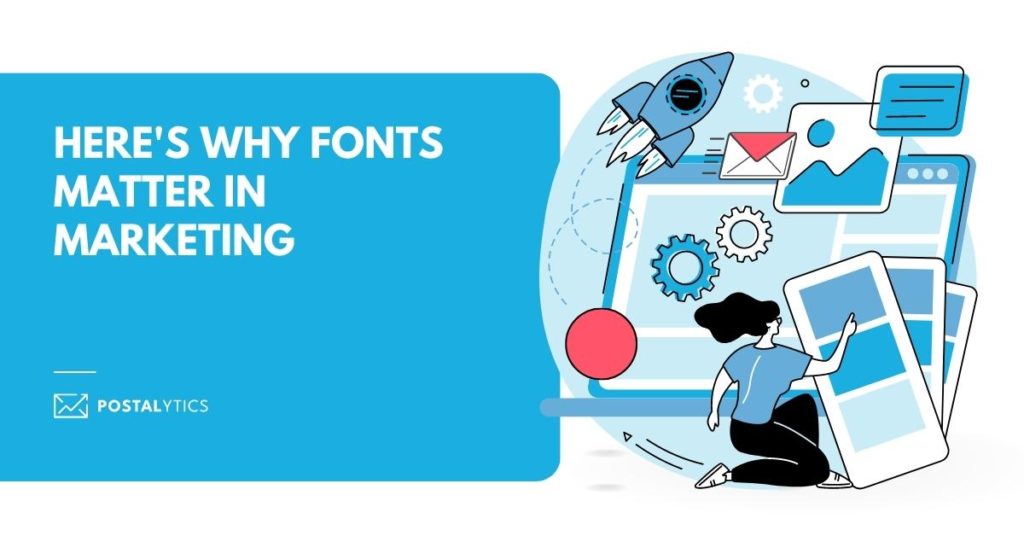
As the leading direct mail automation platform, we spend a lot of time studying fonts that work best in various use cases.
A direct mail piece often offers limited real estate, so it’s important that all elements work as hard as possible to engage and convert recipients. Direct mail designers must choose color, type of paper, images, and a strong call to action. They must take the same care with fonts.
Not as splashy or in-your-face as color options, fonts can be extremely effective at supporting a marketing message and brand identity.
The world of fonts is wonderfully intricate, with a history as old as printing itself. Let’s start with the difference between fonts and typefaces. Today, the terms are interchangeable when talking in general, and most people don’t distinguish between the two. But it’s helpful to understand the difference, especially when talking to art directors.
A typeface is a family of fonts that all share similar design aspects. For example, Helvetica, Baskerville, and Arial are all typefaces, while Helvetica bold, Baskerville italics, or Arial Narrow is all fonts. A typeface can have many fonts in its family.
The world of fonts is also very broad. There are a lot of typefaces and fonts out there. Each project’s attributes, like power, authority, whimsy, and trustworthiness, all affect how customers perceive a brand. Font differences are based on height, weight, the thickness of the lines, curviness vs straight lines, and serifs.
How Fonts Support the Marketing Message
- Audience – Are they an older or a younger group? Traditionally minded or more contemporary? What variety of font is most likely to elicit a response? Older recipients, for example, may respond to a serif typeface because that’s what they’re used to seeing in magazines and newspapers. Younger ones, used to reading on screens, may be more open to sans serif fonts because those are more commonly used on websites.
Serif fonts, like Times Roman, have little tails on the characters. Sans serif fonts, like Helvetica, do not.
- Brand Messaging – A financial institution writing to clients about wealth management will not want to use a decorative font, for example, but a more traditional one that communicates success and stability. A hip restaurant can opt for more whimsy.
- Readability – Pay attention to body size, so readers don’t have to strain their eyes. Kerning and leading also impact readability. Large blocks of type are harder to take in if the characters are in all caps. Even a bold font at 12 points is extremely difficult to make out when knocked out of a dark background. Letters printed in color can be difficult to distinguish. Decorative fonts, like calligraphy or those frenetic, highly decorated, and loud versions, should be used sparingly because they can be difficult to process if used abundantly. Fonts used to display alphanumeric character strings like discount codes, or passwords should make it easy to distinguish zeros and ones from the letters O, I, and L.
Kerning refers to the space between certain letter pairs in a font with variable-width characters.
Leading is the vertical space between lines.
- Hierarchy – Our eyes zoom in on the most obvious element of any direct mail piece and move in sequence to other elements. Fonts are perhaps the most effective signposts to lead readers around. Large fonts are great for headings, moving gradually to blocks of text in descending size.
- Cohesiveness – Mixing too many fonts is a tantalizing rookie mistake. Pros know this only creates a hot mess that lacks cohesiveness and makes a direct mail piece difficult to read. Two or three fonts are enough to create contrast and interest but still maintain a unified approach. We can say the same for upper and lower cases.
- Consistency – Using similar fonts and typefaces across channels is also a fundamental sound design. It’s a good visual bridge that ties everything to a brand. Disunity creates doubt.
Balancing the need for eye-catching designs that stand out with readability and a clear message is often like performing magic, and it can be a very subjective exercise. Think of fonts as the anchors of every successful direct mail piece—they’re not the first thing that catches the eye, but they provide the substance.
About the Author

Dennis Kelly
Dennis Kelly is CEO and co-founder of Postalytics. Dennis joined Boingnet, the predecessor to Postalytics, in 2013. Boingnet was focused on providing print and direct mail marketing service providers the ability to add digital marketing channels to their direct mail campaigns. Postalytics is Dennis’ 6th startup. He has been involved in starting and growing early-stage technology ventures for over 30 years and has held senior management roles at a diverse set of large technology firms including Computer Associates, Palm Inc. and Achieve Healthcare Information Systems.
